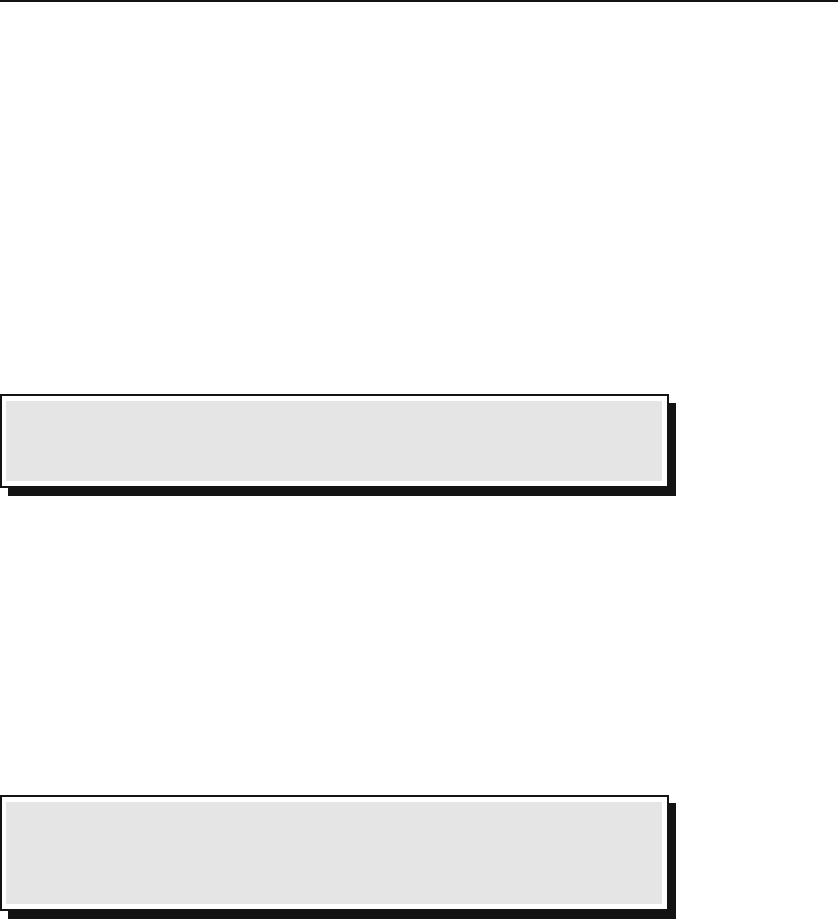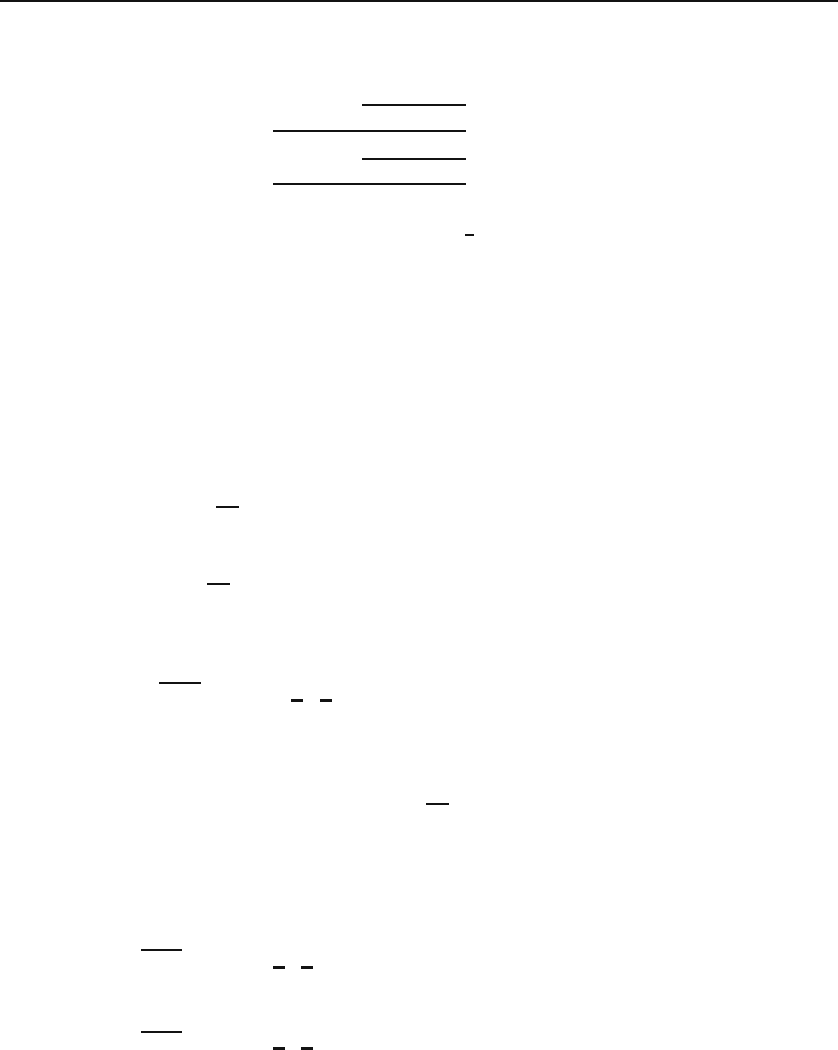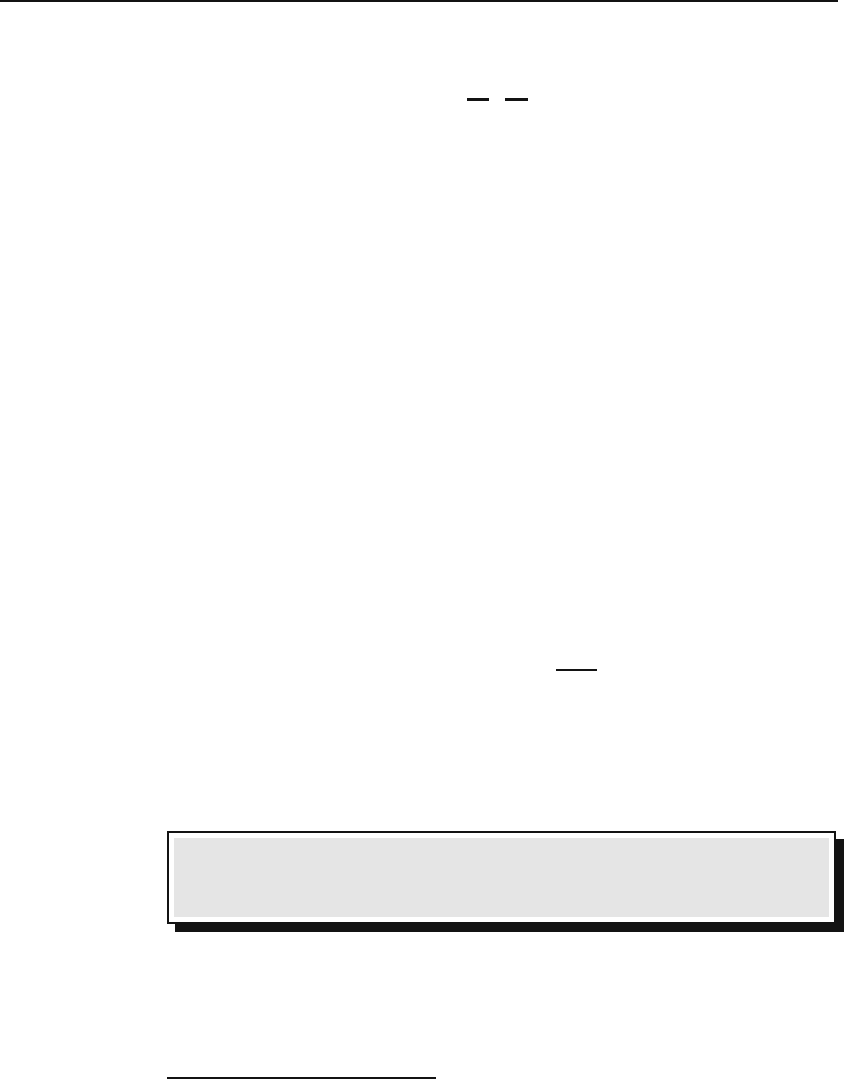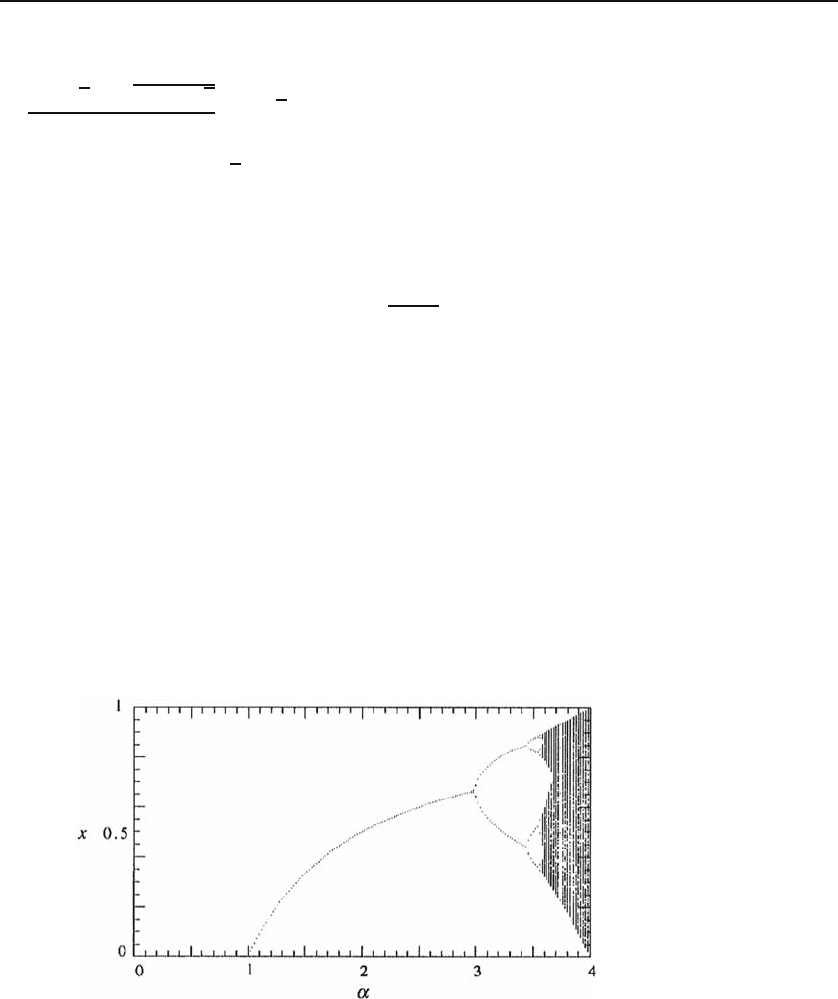Hassani S. Mathematical Methods: For Students of Physics and Related Fields
Подождите немного. Документ загружается.


30.4 Problems 751
30.9. Among all curves joining a given point (0,b)onthey-axistoapoint
on the x-axis and enclosing a given area S together with the x-axis, find the
curve which generates the least area when rotated about the x-axis.
30.10. An Atwood machine consists of two masses m
1
and m
2
connected by
a light inextensible cord of length l which passes over a pulley whose radius
is a and whose moment of inertia is I.Letx denote the distance of m
1
from
the top of the pulley. Using Lagrangian methos, show that the acceleration
of m
1
is
¨x =
g(m
1
− m
2
)
m
1
+ m
2
+ I/a
2
.
30.11. Using polar coordinates, write the Lagrangian of a particle of mass m
moving in a central force field with potential Φ(r). Show that the equations
of motion are
m¨r = mr
˙
θ
2
−
dΦ
dr
,
d
dt
(mr
2
˙
θ)=0.
30.12. Using Lagrangian method, find the acceleration of a solid sphere
rolling without sliding down an inclined plane having an angle θ with the
horizontal.
30.13. Using Lagrangian method, find the acceleration of a solid sphere
rolling without sliding down a movable wedge of mass M having an angle
θ. The wedge moves on a frictionless horzontal surface.
30.14. Two blocks of equal mass m are connected by an inextensible cord
whose linear mass density is μ. One block is placed on a smooth horizontal
table, the other hangs over the edge of the table. What is the acceleration of
the system? Use the Lagrangian method.
30.15. A simple pendulum of length l and mass m oscillates about its point of
support which is attached to a block of mass M moving without friction along
a horizontal line lying in the plane of the pendulum. Write the Lagrangian in
terms of x, the position of M on the horizontal line, and θ, the angle l makes
with the vertical. Find the equations of motion of m and M .
30.16. Find the equation of a curve describing the equilibrium position of
a uniformly dense heavy flexible inextensible cord of length l fastened at its
ends. Hint: The Lagrangian is just the potential energy written as an integral.
30.17. Show that the Lagrangian density (30.43) can be written as
L =
1
2
|B|
2
−|E|
2
+ μ
0
(ρΦ −J · A) .
Hint: See Sections 17.3.1 and 17.3.2 and be careful about possible change of
sign when raising or lowering indices.
30.18. Show that the Lagrangian density (30.47) leads to the Klein-Gordon
equation.

Chapter 31
Nonlinear Dynamics
and Chaos
A variety of techniques including the Frobenius method of infinite power series
could solve almost all linear DEs of physical interest. However, some very fun-
damental questions such as the stability of the solar system led to DEs that
were not linear, and for such DEs no analytic (including series representation)
solution existed. In the 1890s, Henri Poincar´e, the great French mathemati-
cian, took upon himself the task of gleaning as much information from the
DEs describing the whole solar system as was possible. The result was the
invention of one of the most powerful branches of mathematics (topology) and
the realization that the qualitative analysis of (nonlinear) DEs could be very
useful.
One of the discoveries made by Poincar´e, which much later became the
cornerstone of many developments, was that
Box 31.0.1. Unlike the linear DEs, nonlinear DEs may be very sensitive
to the initial conditions.
In other words, if a nonlinear system starts from some initial conditions and
develops into a certain final configuration, then starting it with slightly dif-
ferent initial conditions may cause the system to develop into a final config-
uration completely different from the first one. This is in complete contrast
to the linear DEs where two nearby initial conditions lead to nearby final
configurations.
In general, the initial conditions are not known with infinite accuracy.
Therefore, the final states of a nonlinear dynamical system may exhibit an
indeterministic behavior resulting from the initial (small) uncertainties. This
is what has come to be known as chaos. The reader should note that the inde-
chaos due to
uncertainty in
initial conditions
terminism discussed here has nothing to do with the quantum indeterminism.

754 Nonlinear Dynamics and Chaos
All equations here are completely deterministic. It is the divergence of the
initially nearby—and completely deterministic—trajectories that results in
unpredictable final states.
There are two general categories exhibiting chaotic behavior: systems
obeying iterated maps and systems obeying DEs. We shall study the first
category in some detail, and only outline some of the general features of the
much more complicated category of systems obeying DEs.
31.1 Systems Obeying Iterated Maps
Consider the population of a species in consecutive years if the population is
initially N
0
. The simplest relation connecting N
1
, the population after one
year, to N
0
is
N
1
= αN
0
,
where α is a positive number depending on the environment in which the
species lives. Under the most favorable conditions, α is a large number, indi-
cating rapid growth of population. Under less favorable conditions, α will be
small. And if the environment happens to be hostile, then α will be smaller
than one, indicating a decline in population.
The above equation is unrealistic because we know that if α>1andthe
population grows excessively, there will not be enough food to support the
species. So, there must be a mechanism to suppress the growth. A more
realistic equation should have a suppressive term which is small for small N
0
and grows for larger values of N
0
. A possible term having such properties is
one proportional to N
2
0
. This leads to
N
1
= αN
0
− βN
2
0
where 0 <β α.
The minus sign causes the second term to decrease the population. Iterating
this equation, we can find the population in the second, third, and subsequent
years:
N
2
= αN
1
− βN
2
1
,N
3
= αN
2
− βN
2
2
,...,
and, in general,
N
k+1
= αN
k
− βN
2
k
. (31.1)
It is customary to rewrite (31.1) in a slightly different form. First we note
that since population cannot be negative, there exists a maximum number
beyond which the population cannot grow. In order for N
k+1
to be positive,
we must have
αN
k
− βN
2
k
> 0 ⇒ N
k
<
α
β
for all k. It follows that N
max
= α/β. Dividing (31.1) by N
max
yields
x
k+1
= αx
k
(1 −x
k
), (31.2)

31.1 Systems Obeying Iterated Maps 755
where x
k
is the fraction of the maximum population of the species after k
years, and therefore, its value must lie between zero and one. Any equation
of the form
x
k+1
= f
α
(x
k
), (31.3)
where α is—as in the case of the logistic map—a control parameter, and in
which a value of some (discrete) quantity at k + 1 is given in terms of its value
at k, is called an iterated map, and the function f
α
is called the iterated iterated map,
iterated map
function, and
logistic map
function
map function. The particular function in (31.2) is called the logistic map
function.
Starting from an initial value x
0
, one can generate a sequence of x values
by consecutively substituting in the RHS of (31.3). This sequence is called a
trajectory or orbit of the iterated map.
31.1.1 Stable and Unstable Fixed Points
It is clear that the first few points of an orbit depend on the starting point.
What may not be so clear is that, for a given α, the eventual behavior of
the orbit is fairly insensitive to the starting point. There are, however, some
starting points which are manifestly different from others. For example, in the
logistic map, if x
0
= 0, no other point will be produced by iteration because
f
α
(0) = 0 or f
α
(x
0
)=x
0
, and further application of f
α
will not produce any
new values of x. In general, a point x
α
which has the property that
f
α
(x
α
)=x
α
(31.4)
is called a fixed point of the iterated map associated with α. For the logistic
fixed point of an
iterated map
map we have
x
α
= αx
α
(1 −x
α
) ⇒ x
α
(1 −α + αx
α
)=0 ⇒ x
α
=0, 1 −
1
α
. (31.5)
Since 0 ≤ x
α
≤ 1, there is only one fixed point (i.e., x =0)forα ≤ 1, and
two fixed points (i.e., x =0andx =1−1/α)forα>1.
What is the significance of fixed points? When α<1, Equation (31.2)
shows—since both x
k
and 1 −x
k
are at most one—that the population keeps
decreasing until it vanishes completely. And this is independent of the initial
graphical way of
approaching a
fixed point
value of x. It is instructive to show this pictorially. Figure 31.1(a) shows the
logistic map function with α =0.5. Start at any point x
0
on the horizontal
axis; draw a vertical line to intersect the logistic map function at f(x
0
) ≡ x
1
;
from the intersection draw a horizontal line to intersect the line y = x at y
1
=
x
1
; draw a vertical line to intersect the logistic map function at f (x
1
) ≡ x
2
;
continue to find x
3
and the rest of x’s. The diagram shows that the x’s are
getting smaller and smaller.
What happens when α>1? Figure 31.1(b) shows the logistic map function
with α = 2. We note that the orbit is attracted to the fixed point at x =
0.5. We also note that the fixed point at x = 0 has now turned into a

756 Nonlinear Dynamics and Chaos
α
= 2
y = f
(
x
)
1
1
0
x
y
y = x
1
α
= 0.5
y = f
(
x
)
1
0
x
3
x
0
x
2
x
1
y
y = x
f (x
0
)
(a) (b)
x
0
x
3
x
2
x
1
Figure 31.1: (a) Regardless of the value of x
0
, the orbit always ends up at the origin
when α<1.(b)Evenforα>1, it appears that the orbit always ends up at some
attractor regardless of the value of x
0
. Note that now the origin has become a “repellor.”
“repellor.” We can treat the behavior of the logistic map at general fixed
points analytically.
First let us consider a general (one-dimensional) iterated map as given by
Equation (31.3). We are seeking the fixed points of (31.3). These points—
commonly labeled by an asterisk—satisfy
x
∗
= f
α
(x
∗
),
i.e., they are intersections of the curves y = x and y = f
α
(x)inthexy-plane.
An important property of fixed points is their stability—or whether they are
attractors or repellors. To test this property, we Taylor-expand the iterated
stability of fixed
points
map function around x
∗
, keeping the first two terms:
x
k+1
= f
α
(x
k
)=f
α
(x
∗
)+
df
α
dx
x
∗
(x
k
− x
∗
)=x
∗
+
df
α
dx
x
∗
(x
k
− x
∗
)
or
|x
k+1
− x
∗
|
|x
k
− x
∗
|
=
df
α
dx
x
∗
= |f
α
(x
∗
)|.
So, x
k+1
will be farther away from (or closer to) x
∗
than x
k
if the absolute
value of the derivative of the function is greater than one (or less than one).
analytic criterion
for stability of a
fixed point of an
iterated map
Box 31.1.1. Afixedpointx
∗
of an iterated map (31.3) is stable if
|f
α
(x
∗
)| < 1 and unstable if |f
α
(x
∗
)| > 1.
Example 31.1.1. For the logistic map, f
α
(x)=αx(1−x)sothatf
α
(x)=α−2αx.
The fixed points are x
∗
1
=0andx
∗
2
=1−1/α. Therefore,
f
α
(x
∗
1
)=f
α
(0) = α and f
α
(x
∗
2
)=f
α
(1 − 1/α)=2− α. (31.6)

31.1 Systems Obeying Iterated Maps 757
It follows that the fixed point at x = 0 is stable (attractive) if α<1, while for
this same value of α the fixed point x
∗
2
is unstable (repulsive). Thus, for α<1, all
trajectories are attracted to the fixed point at x =0.
Equation (31.6) also shows that for 1 <α<3, the other fixed point becomes
stable while the fixed point at the origin becomes unstable. This is also consistent
with the behavior of the logistic map depicted in Figure 31.1(b).
The criterion of Box 31.1.1 can also be stated graphically. Since 1 is the
slope of the line y = x, and since a fixed point is an intersection of the two
curves y = x and y = f
α
(x), the criterion of Box 31.1.1 is a comparison of the
slope of the tangent to y = f
α
(x)withtheslopeofy = x:Afixedpointx
∗
of an iterated map (31.3) is stable, if the acute angle that the tangent line at
(x
∗
,f
α
(x
∗
)) makes with the x-axis is smaller than the corresponding angle of
the line y = x. If this angle is larger, then the fixed point is unstable. This is
equivalent to the simpler statement:
graphical criterion
for stability of a
fixed point of an
iterated map
Box 31.1.2. Afixedpointx
∗
of an iterated map f
α
(x) is stable (unstable)
if immediately to the right of x
∗
,thecurvey = f
α
(x) lies below (above)
the line y = x.
31.1.2 Bifurcation
Although the logistic map has no stable fixed points beyond x
α
=1−1/α,we
may ask whether there are points at which the iterated map is “semi-stable.”
What does this mean? Instead of demanding strict stability or instability, let
us consider a case in which the map may oscillate between two values.This
situation is neither completely stable nor completely unstable: Although the
system moves away from the point in question, it does not leave it forever.
Suppose that just above the largest value of a stable α, the system starts to
oscillate between two values of x. This is an example of bifurcation:
bifurcation and
period doubling
Box 31.1.3. When the development of a system splits into two regions as
a parameter of the equations of motion of the system increases slightly, we
say that a bifurcation has occurred and call the splitting of the trajectory
a period-doubling bifurcation.
Suppose that there are two “fixed” points x
∗
1
and x
∗
2
between which the
function oscillates such as the two points illustrated in Figure 31.2(a). These
fixed points must satisfy
x
∗
2
= f
α
(x
∗
1
),x
∗
1
= f
α
(x
∗
2
). (31.7)
To gain further insight into the behavior of the logistic map, we introduce the
so-called second iterate of f
α
denoted by f
[2]
α
and defined by second iterate

758 Nonlinear Dynamics and Chaos
x
0
0
0.2
1
0.558
0.7646
(a)
(b)
Figure 31.2: (a) For α =3.1, there are clearly two attractors located at x =0.5580
and x =0.7646.(b)Forα =3.99, no attractor seems to exist because the iterations
do not seem to converge in the diagram.
f
[2]
α
(x) ≡ f
α
(f
α
(x)). (31.8)
From this definition, it is clear that every fixed point of f
α
is also a fixed
point of f
[2]
α
. However, the converse statement is not true. In fact, x
∗
1
and x
∗
2
defined in Equation (31.7) are fixed points of f
[2]
α
:
f
[2]
α
(x
∗
1
)=f
α
(f
α
(x
∗
1
)) = f
α
(x
∗
2
)=x
∗
1
,
f
[2]
α
(x
∗
2
)=f
α
(f
α
(x
∗
2
)) = f
α
(x
∗
1
)=x
∗
2
,
but not of f
α
. It now follows that fixed points of f
[2]
α
give information about
period-doubling bifurcation.
For the logistic map, f
[2]
α
can be found easily:
f
[2]
α
(x)=f
α
(f
α
(x)) = αf
α
(x)[1 −f
α
(x)]
= α[αx(1 −x)][1 −αx(1 − x)] = α
2
x(1 − x)(1 −αx + αx
2
)
= −α
3
x
4
+2α
3
x
3
− (α
2
+ α
3
)x
2
+ α
2
x. (31.9)
The fixed points of f
[2]
α
(x) are, therefore, determined by the equation
x = −α
3
x
4
+2α
3
x
3
− (α
2
+ α
3
)x
2
+ α
2
x
which shows that there are, in general, four fixed points, one at x =0,and
three others satisfying the cubic equation
α
3
x
3
− 2α
3
x
2
+(α
3
+ α
2
)x −α
2
+1=0. (31.10)
We can actually solve this equation because we know that one of its roots is
x
1
(α)=1− 1/α,afixedpointoff
α
(x). The cubic polynomial in Equation

31.1 Systems Obeying Iterated Maps 759
(31.10) can thus be factored out as α
3
[x−x
1
(α)] times a quadratic polynomial
whose roots give the remaining solutions to (31.10). The reader may verify
that these roots are
x
2
(α)=
1+α +
√
α
2
− 2α − 3
2α
,
x
3
(α)=
1+α −
√
α
2
− 2α − 3
2α
. (31.11)
These two functions start out at the common value of
2
3
when α = 3. Then, as
a function of α, x
2
(α) monotonically increases and asymptotically approaches
1; x
3
(α) monotonically decreases and asymptotically approaches 0.
We are interested in those values of α for which the fixed points are not
completely unstable. In the present case, this means that the value of the
iterated map must oscillate between only two values. This will happen only
if the two points are stable fixed points of f
[2]
α
. Since by Box 31.1.1 stability
imposes a condition on the derivative of the function, we need to look at the
derivative of f
[2]
α
.
Using the chain rule, which in its most general form is
d
dx
[g(h(x))] = g
(h(x))h
(x)
we obtain
d
dx
f
[2]
α
(x)=[f
α
(f
α
(x))]f
α
(x). (31.12)
In particular, if x happens to be a fixed point x
∗
of f
α
,then
df
[2]
α
dx
x
∗
= f
α
(f
α
(x
∗
)
=x
∗
)f
α
(x
∗
)=[f
α
(x
∗
)]
2
. (31.13)
This shows that if x
∗
is a stable fixed point of f
α
,then
|f
α
(x
∗
)| < 1 ⇒ [f
α
(x
∗
)]
2
< 1 ⇒
d
dx
f
[2]
α
(x
∗
)
< 1
and x
∗
is a stable fixed point of f
[2]
α
as well. Furthermore, at the two fixed
points of f
[2]
α
discussed above, Equation (31.12) yields
df
[2]
α
dx
x
∗
1
= f
α
(f
α
(x
∗
1
)
x
∗
2
)f
α
(x
∗
1
)=f
α
(x
∗
2
)f
α
(x
∗
1
),
df
[2]
α
dx
x
∗
2
= f
α
(f
α
(x
∗
2
)
x
∗
1
)f
α
(x
∗
2
)=f
α
(x
∗
1
)f
α
(x
∗
2
). (31.14)
It follows that f
[2]
α
has the same derivatives at these two points.

760 Nonlinear Dynamics and Chaos
The concept of iteration of f
α
can be readily generalized. The nth iteratenth iterate
of f
α
is
f
[n]
α
≡ f (f (...f
n times
(x) ...))
and as in the case of f
[2]
α
, the fixed points of f
α
are also fixed points of f
[n]
α
and
the stable fixed points of f
α
are also stable fixed points of f
[n]
α
. The converse
of neither of these statements is, in general, true.
The utility of the concept of the nth iterate comes in the analysis of the
location of bifurcation points. To be specific, let us go back to the logistic map
and Equation (31.6). The stable points, being characterized by the absolute
value of the derivative of the map function, occur at x =0when0<α<1
and at x =1− 1/α when 1 <α<3. Within the α-range of stability, the
derivative of f
α
ranges between
1
−1and+1,startingwith+1atα =1and
ending with −1atα = 3 [see the second equation in (31.6)]. Beyond this
value of α—which is the parameter at which the 2-cycle fixed point occurs
and which we now denote by α
1
—f
α
has no stable points. Equation (31.13),
however, shows that the derivative of f
[2]
α
is +1 there. This means that the
derivative of f
[2]
α
can decrease down to −1asα increases beyond α
1
.Infact,
what happens as α increases past α
1
is precisely a repetition of what happened
to f
α
between α =1andα = 3: The derivative of f
[2]
α
keeps decreasing until
at a certain value of α denoted by α
2
a period-doubling bifurcation occurs
for f
[2]
α
. This corresponds to a 4-cycle fixed point. Thus a 4-cycle fixed point4-cycle fixed point
x
∗
, as well as the corresponding value of α, is obtained by imposing the two
requirements
f
[2]
α
2
(x
∗
)=x
∗
and
df
[2]
α
2
dx
x
∗
= −1. (31.15)
This equation entails an important result. By Equation (31.14), the derivative
of f
[2]
α
2
at its two stable points are equal. Therefore, both stable points give
rise to the same pair of equations (31.15). In particular,
Box 31.1.4. Any value of α
2
that gives a solution for the first fixed point
must also give a solution for the second fixed point. In fact, we should ex-
pect two values of x
∗
for every α
2
that solves the pair of equations (31.15).
For the logistic map, Equation (31.15) becomes [see (31.9)]
x
∗
= α
2
2
x
∗
(1 −x
∗
)(1 −α
2
x
∗
+ α
2
x
∗2
),
−1=−4α
3
2
x
∗3
+6α
3
2
x
∗2
− 2(α
2
2
+ α
3
2
)x
∗
+ α
2
2
.
1
The x = 0 is an exception because we are assuming that α is a positive quantity,
therefore, f
(0) = α cannot be negative.

31.1 Systems Obeying Iterated Maps 761
One can solve these equations and obtain eight possible pairs (x
∗
,α
2
). The
only two acceptable real pairs which have a value of α
2
larger than three are
4+
√
6 ±
14 − 4
√
6
10
, 1+
√
6
=(0.644949 ± 0.204989, 3.44949). (31.16)
In particular, α
2
=1+
√
6=3.44949 is the 4-cycle fixed point depicted in
Figure 31.3 corresponding to the two x values of approximately 0.85 and 0.44.
The generalization to 2
n
-cycles is now clear. One simply constructs the
2
n
th iterate of f
α
and solves the two equations
f
[2
n
]
α
(x
∗
)=x
∗
and
df
[2
n
]
α
dx
x
∗
= −1.
In practice, these are too complicated to solve analytically, but numerical
methods are available for their solution. Each solution consists of a pair
(x
∗
n
,α
n
)wherex
∗
n
is the 2
n
-cycle fixed point and α
n
is the corresponding
control parameter. As in the case of f
[2]
α
, for each acceptable α
n
,thereare2
n
fixed points.
31.1.3 Onset of Chaos
Suppose we keep increasing α slowly. It may happen that at a certain value of
α no finite set of “stable” points exists. A graphical analysis of this situation
is depicted in Figure 31.2(b) showing that the behavior of the logistic map
is chaotic. What is the relation between the value of α at which chaos sets
in (which we denote by α
c
)andα
n
? Considering the chaotic behavior as
Figure 31.3: The bifurcation diagram for the logistic map. The behavior of the function
is analytically very simple for α<3.Forα>3, the behavior is more complicated. The
4-cycle fixed points are clearly shown to occur at α ≈ 3.45. From approximately 3.57
onward, chaotic behavior sets in.
